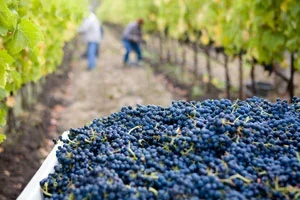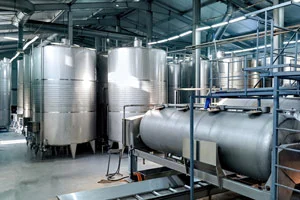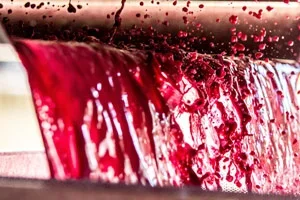Aromatic explosion
When we talk about aroma in wine, we value several different aspects at once. The grape variety, the type of winemaking process, the desired character or the ageing process are all responsible for the organoleptic qualities of the wine, with aromatic complexity being one of the first aspects to have an impact on the consumer, thus making it possible to assess its quality.
During the harvest, a multitude of physical, chemical and biological processes take place that result in the production, release and transformation of volatile compounds which will ensure the quality of the final wine. For this reason, it is particularly important to ensure at this time both the absence of defects (“FERMENTATION GUARANTEE” AND “BIOCONTROL”) and the enhanced efficiency of the process at various points: extraction, metabolism and conservation.
Potential grape extraction
Obtaining a wine with maximum varietal expression means enhancing the extraction of aromatic and polyphenolic compounds during grape maceration. The transfer of organoleptically interesting compounds will occur both during alcoholic fermentation, favoured by the solvent action of alcohol, and prior to fermentation, as certain compounds (such as aromatic precursors or anthocyanins) are diffused in the aqueous phase. In the case of white wine production, skin maceration and maceration in the barrels are favoured by the use of enzyme preparations (Enozym) and are strategies for a greater release of varietal aromatic precursors. In the case of red wines, a good wetting of the solid phase is key for proper extraction. For this purpose, an effective rupture of the ULISES TDR2 cap must be guaranteed to prevent the formation of preferential channels through which the must would not allow the extraction of aromas and polyphenols from areas without contact between the must and the skins. Technological advances in oenology have made it possible to demonstrate how the application of high-power, low-frequency ultrasound facilitates the release of aromatic precursors located in the plant cell, as well as polyphenolic compounds in red wines. The sonication of the grapes after reception and destemming through the ULTRAWINE – PERSEO system causes a collapse of the plant cell, rupturing the structures that contain these compounds, favouring their transfer to the environment. Plant cell with defined organelles after sonication.
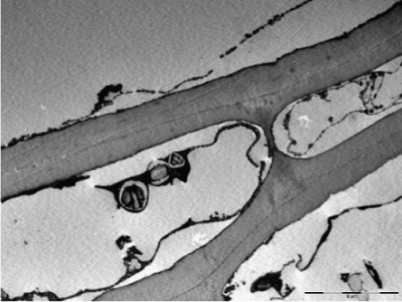
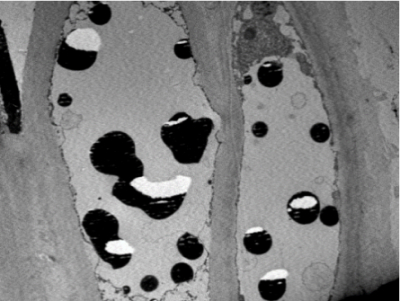
ULTRAWINE PERSEO
The production of wines that have been subjected to the ULTRAWINE PERSEO process are able to achieve excellent quality, obtaining:
- Wines of high quality and chromatic stability, with maceration times reduced byup to 50%.
- Wines with a greater varietal character thanks to up to 40% more aromatic precursors than those that are not sonicated.
- More sustainable wines due to the energy savings derived from the application of ultrasound prior to vatting, reducing consumption by up to 15%.
Ultrasound technology is also an ideal tool for obtaining balanced wines from grapes known as “climate change grapes”, where achieving a balance between phenolic potential and alcoholic strength is a work of oenological engineering.
Enhancement of precursors and protection of oxidation
Oenological tools allow wineries to make up for shortcomings that in some cases can be identified at the time of harvesting. A deficient sanitary situation or an imbalance in the ripening process can mean that the grapes are not received at the moment when the product is of the highest quality.
The correction of the must with organic nutrition will be fundamental not only for the correct development of alcoholic fermentation but also to achieve the maximum aromatic expressiveness of the wines. The use of Acimax Natura or Actimax Varietal in the early stages of alcoholic fermentation facilitates:
The genesis of fermentative aromas: Amino acids are the basis of volatile compounds produced by yeasts. One third of the higher alcohols are produced during the onset of alcoholic fermentation from amino acids. The esterification of these alcohols gives rise to fruity aromas that bring complexity and longevity to the wine.
Increased varietal aromas: amino acids (organic nutrition) also accentuate aromatic complexity, increasing varietal registers. Good nitrogen nutrition results in the optimal performance of the enzymes (proteins) responsible for the release of aromatic precursors present in the grape: ß-glycosidases and ß-lyases, increasing the varietal registers of the wine.
Actimax Natura
Organic activator, 100% autolysed yeast, with a high proportion of amino acid content. Provides amino acids for the generation of transport proteins and enzymes.
It ensures the content of easily assimilable nitrogen (NFA), thus avoiding the need to use ammonium salts.

Actimax Varietal
Balanced organic nutrient for alcoholic fermentation. Indicated to express the varietal potential of white and red grapes and protect their evolution over time. It has a high natural antioxidant capacity, due to the double effect provided by its high content of reduced glutathione and metal sequestering capacity. As a result, the aromas released are protected and their evolution over time is delayed.
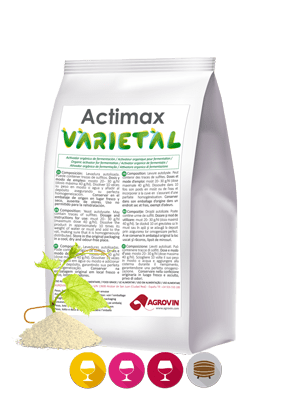
Working from the moment of harvesting with different types of tannins can help improve the quality of wines which, for various reasons, do not come from grapes of optimum quality or in which all the potential extracted is to be preserved without any deterioration or oxidation of the compounds obtained.
Oenological tools allow wineries to make up for shortcomings that in some cases can be identified at the time of harvesting. A deficient sanitary situation or an imbalance in the ripening process can mean that the grapes are not received at the moment when the product is of the highest quality.
Working from the moment of harvesting with different types of tannins can help improve the quality of wines which, for various reasons, do not come from grapes of optimum quality or in which all the potential extracted is to be preserved without any deterioration or oxidation of the compounds obtained.
Tanicol ONE
With its high antioxidant capacity, this tannin preserves the aromatic and phenolic potential of wines. Its ability to react with quinones leaves them inactive and prevents them from giving rise to secondary chain reactions that lead to the degradation of aromas and the browning of the wine colour.

Tanicol Redsense
The combination of different types of tannins enhances the aromas of red wines, giving them freshness and intensity with a greater perception of varietal and red fruit aromas.
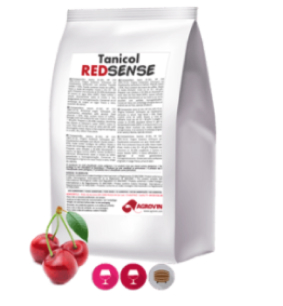
Release and preservation of aromas
Varietal aromas, terpenes and thiols, are mainly found in the must in the form of aromatic precursors and their release will be necessary to express their characteristic aromas. These aromatic precursors can be in the form of glycosides, bound to a sugar molecule, as in the case of terpenes and nor-isoprenoids, or to an amino acid, as in the case of thiols.
During alcoholic fermentation, a complex map of metabolic processes carried out by the yeast takes place that will result in fermentative aromas. However, yeast will also be a revealer of varietal aromas, its ability to produce the enzymes β-lyase and/or β-glicosidasa will allow the cleavage of aromatic precursors and their transformation into volatile compounds, perceptible and of great oenological value. In the case of the release of terpenic and nor-isoprenoid aromas, the activity β-glicosidasa can also be provided by the application of certain enzyme pools.

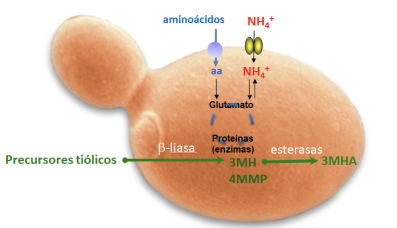
In order to achieve the maximum expression of varietal aromas, several factors need to be in place:
This will depend on the variety and the flow of work with the must (pre-fermentative macerations/stabilisations) that allows the maximum amount of must to be extracted.
The yeast will have to have its own genetic capacity that leads to the formation of enzymes:
For thiol varieties: revealing (β-lyase) of the thiols 3MH and 4MMP from their cysteinated precursors, Viniferm REVELATION; and transforming (esterase) for the formation of 3MHA, Viniferm DIANA.
In the case of terpenic varieties: glycosidase activity for the release of terpenes bound to a sugar, Viniferm ELEGANCIA.
Enzyme preparations: in the case of glycosylated aromatic precursors, β-glycosidase activity may be added. These enzymatic preparations can be applied both in must, Enozym EXTRA AROME; and in white wine to favor the development of varietal aromas, Enovin VARIETAL.
Low temperatures decrease the release of thiols, while temperatures around 18º C or higher favour them. The first 3-5 days of fermentation is when the temperature effect is greater. It is important to ensure high levels of NFA (>200 mg/L) for the proper formation of the enzymes responsible for the release of thiols, avoiding ammonium salts in the initial stages. which cause NCR (Nitrogen Catabolic Repression).
Once released from their cysteine conjugation, thiols are very sensitive to oxidation and must be protected by oenological strategies such as inertisation, the use of glutathione and the removal of oxidation catalyst metals (Cu and Fe).
Although thiol aromas are mainly associated with white wines, they are also important in the production of red wines where their expression gives rise to the presence of very persistent and intense aromas, described as acidic red or black fruits such as blackcurrant and blackberry. Therefore,the strategy for enhancing red wines with these characteristics must include work with yeasts with high β-lyase activity, such as Viniferm ELITE and specific nutrients that combine the balanced supply of nitrogen in the form of NOPA with oxidation protection agents such as Actimax VARIETAL.
